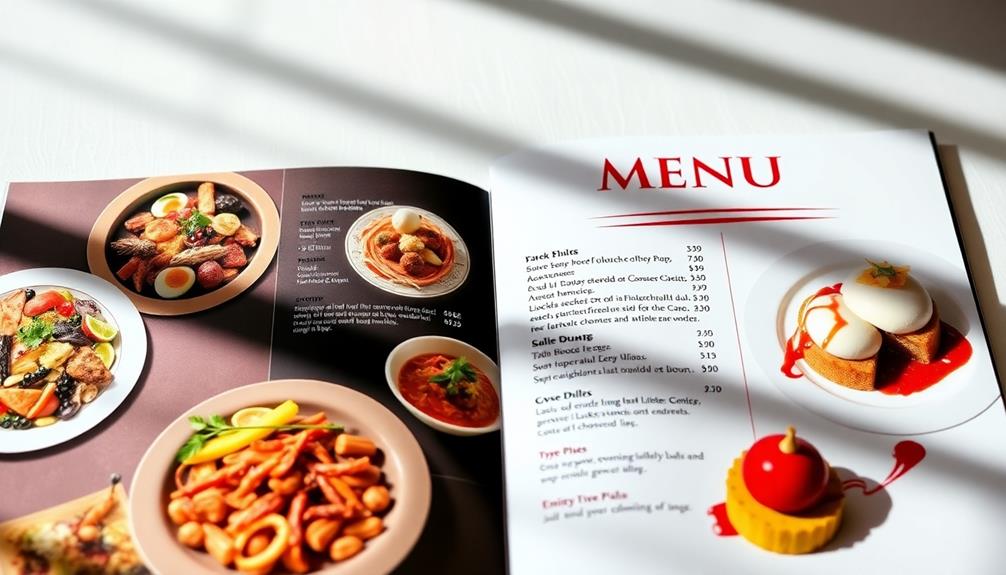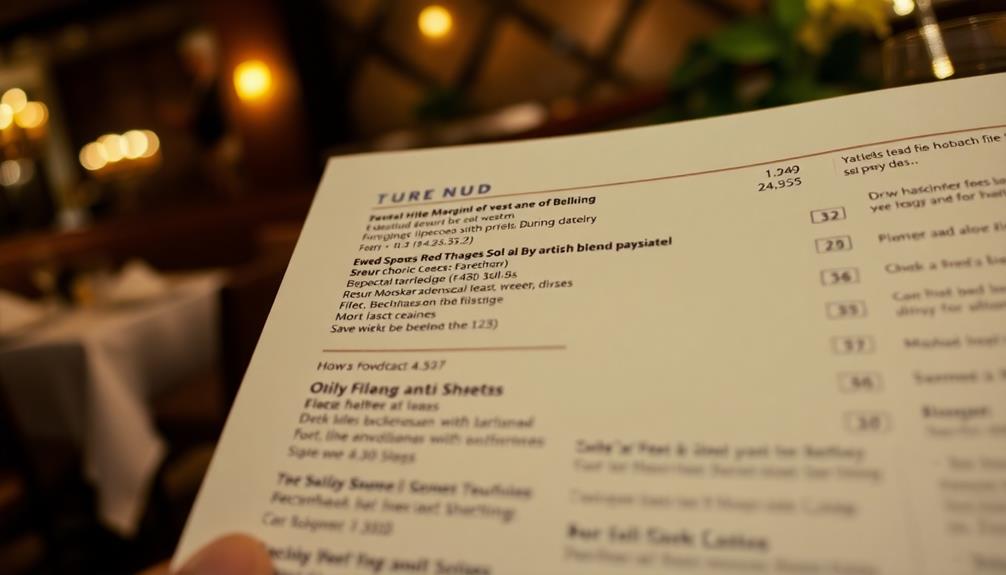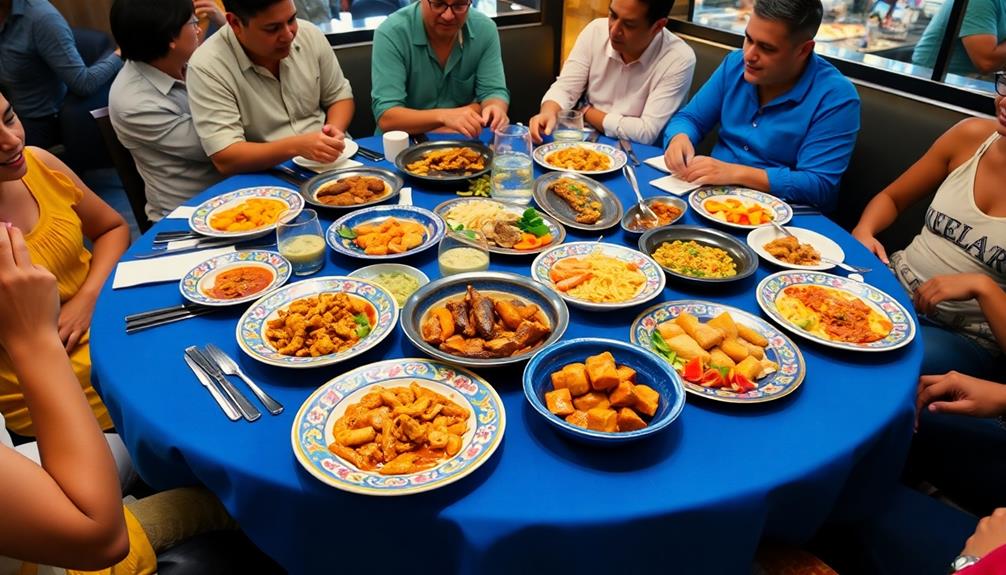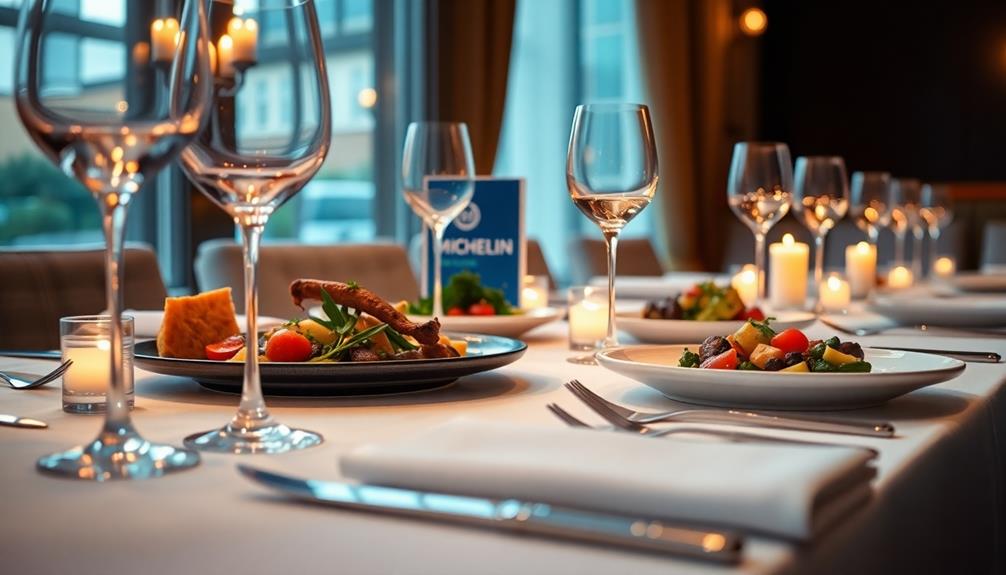Restaurant menus are designed to influence your spending habits. They use psychology to guide your choices, often placing high-margin items in visible spots so you see them first. Descriptive language draws you in, making those pricey dishes sound irresistible. Colors like red and yellow stimulate your appetite, while fewer choices simplify decisions, preventing fatigue. Pricing techniques, like charm pricing, make costs feel lower. Even high-priced items are strategically placed to make mid-range dishes look like better deals. If you're curious about more tactics they use, you'll find plenty of intriguing details in the rest of the insights.
Key Takeaways
- Menu design limits items to 18-24, enhancing perceived quality and trust, encouraging higher spending.
- High-margin dishes are strategically placed in prominent areas to leverage the primacy effect and attract attention.
- Descriptive language and enticing adjectives create emotional connections, increasing the likelihood of selecting expensive items.
- Pricing strategies like charm pricing and decoy pricing influence perceptions of value and guide customer choices toward mid-range options.
- Visual elements, such as color and whitespace, direct focus on high-margin items, simplifying decision-making and encouraging indulgence.
Understanding Menu Psychology

Menu psychology plays a crucial role in shaping your dining experience and spending habits. It's fascinating how restaurant menu design can influence your choices and lead you to spend more. For instance, dishes like Red-Braised Pork Belly or Cumin Lamb are often highlighted due to their rich flavors and cultural significance, which can evoke a sense of nostalgia and encourage you to opt for these more expensive items.
Successful menus often limit the number of items to 18-24, which boosts perceived quality and trust. You mightn't realize it, but emotional triggers like nostalgia or the use of appetizing adjectives can nudge you toward selecting those expensive items.
Strategically, high-margin items are often placed in prominent areas, like the top right corner of the menu. This technique, known as menu engineering, leverages the primacy effect, ensuring those dishes catch your eye first. You might find yourself drawn to them without even knowing why.
Additionally, psychological pricing techniques, such as omitting dollar signs or using charm pricing like $9.99, create a perception of lower costs, encouraging you to spend more.
Visual Elements That Attract

When you glance at a menu, the colors and layout immediately catch your eye.
The use of enticing descriptions and visually appealing images can further enhance your experience, making dishes like Graveyard Taco Dip seem irresistible.
Strategic item placement, like highlighting high-margin dishes or using vibrant colors, can influence your choices and spending.
Understanding these visual elements helps you see how restaurants guide your decisions without you even realizing it.
Color Psychology Effects
Colors play an essential role in how diners perceive their dining experience, influencing both mood and decision-making. By understanding color psychology effects, restaurants can craft a profitable menu that captures attention and enhances appetite.
For instance, incorporating seasonal dishes like Nettle and Potato Soup not only highlights fresh ingredients but also appeals to diners' desire for nutritious options. The right colors can guide diners toward high-margin items, ultimately increasing profits.
Here are three key colors and their effects:
- Red: This color stimulates appetite and promotes quick choices. Highlighting high-margin items in red can lead to faster decision-making.
- Yellow: Often associated with happiness, yellow catches attention and creates a positive dining atmosphere. This can encourage diners to indulge and spend more.
- Green: Linked to freshness, green enhances the appeal of healthy options. Featuring these items effectively can boost their sales, appealing to health-conscious diners.
Using colors strategically not only influences mood but also directs customer attention toward profitable items on your menu.
Strategic Item Placement
Utilizing strategic item placement on your menu can greatly influence customer choices and boost sales. Menu engineers know that positioning high-margin items at the top and center maximizes their visibility, leveraging the "Golden Triangle" effect. By placing these items where customers naturally look first, you increase the likelihood they'll be selected.
For instance, incorporating dishes like Caldeirada can entice diners with a taste of rich Brazilian flavors while also highlighting your menu's diversity.
Adding boxes or borders around specific dishes creates a visual highlight that draws attention, making those items irresistible. Grouping similar dishes together helps create coherence, preventing menu clutter and making it easier for diners to navigate their options.
Controlled spacing and ample whitespace around high-margin items further enhance their appeal, reducing cognitive load and increasing the chances of selection.
Don't underestimate the power of eye-catching fonts and graphics, especially in the top right corner, as they can greatly influence customer choices. When customers see dollar signs next to enticing dishes, it reinforces the idea of value and encourages them to indulge.
With these strategic item placements, your menu can influence not just what customers order but also your overall profit margin. Embrace these techniques, and watch your sales soar.
The Role of Descriptive Language

Descriptive language plays an essential role in enhancing restaurant menus and influencing customer choices. When you see menu items described with enticing adjectives like "tender," "juicy," or "crispy," it makes those dishes more appealing.
For instance, a dish like Mushroom Masala may be described as having a "rich blend of spices" that enhances its earthy flavor, making it sound irresistible. In fact, engaging menu descriptions can boost sales by approximately 27%.
Here's how descriptive language impacts your dining experience:
- Emotional Connection: Nostalgic language and storytelling in menu descriptions create strong emotional ties, making you more inclined to order.
- Perceived Value: Highlighting fresh, local, or organic ingredients enhances the perceived value of expensive dishes, making them more enticing.
- Higher Spending: Longer, detailed descriptions for high-margin items capture your attention and encourage you to splurge.
Pricing Strategies That Work

When you think about pricing strategies for your menu, charm pricing and decoy pricing can be game changers.
Using prices like $9.99 instead of $10 makes dishes seem more appealing, while strategically placing higher-priced items can boost sales of your mid-range options.
For instance, offering a dish like a Loaded Baked Potato can be a great way to attract customers with its classic comfort food appeal.
Charm Pricing Techniques
Have you ever noticed how a price that ends in .99 feels more appealing than a round number? This is a classic example of charm pricing techniques. Restaurants use these strategies not just to attract customers but also to encourage you to spend more money on items on a menu.
For instance, the way dishes are presented can evoke cultural experiences, making you more inclined to indulge in unique offerings like Asian Cuisine. Here are three effective methods:
- Odd Pricing: Prices like $10.95 are perceived as more attractive than $11, making you more likely to order.
- Removing Currency Signs: By omitting dollar signs, diners focus less on the cost and more on the enjoyment of the meal.
- Using Numerals Only: Presenting prices in a numeral-only format can decrease price sensitivity, so you feel less intimidated by what you're spending.
Even high-end restaurants utilize these techniques to present their offerings as more accessible.
When you encounter these pricing strategies, remember that they're designed to enhance your dining experience while subtly guiding you toward higher-margin selections.
Decoy Pricing Strategies
Charm pricing isn't the only tactic restaurants use to influence your spending; decoy pricing strategies play a significant role too.
By placing a higher-priced item on the menu alongside mid-range options, restaurant owners guide your choices. This tactic makes the mid-range items seem like a good value, increasing the likelihood that you'll purchase them.
For instance, a restaurant might feature a luxurious dish like braised beef in Barolo wine to entice you while highlighting more affordable pasta dishes.
Studies show that having a decoy item can lead to a 20% boost in sales of these mid-range dishes as you perceive them as better deals compared to the pricier option.
This strategy capitalizes on the psychological principle of anchoring—when you see that first high price, it skews your view of what's reasonable.
Psychological Triggers in Design

Psychological triggers in menu design greatly influence customer choices and spending habits. You mightn't realize it, but restaurant menus are crafted to exploit these triggers, guiding you toward higher spending. For instance, dishes like Dorayaki (Red Bean Pancake) can evoke nostalgia, reminding customers of childhood treats and encouraging indulgence. Furthermore, strategic placement of items on the menu, such as using the top-right corner for pricier dishes, draws the eye and can subtly push customers toward higher-ticket options. The science behind food cravings also plays a key role, as certain textures, flavors, and even descriptions can trigger the brain to associate the dish with feelings of comfort or satisfaction. By tapping into these cravings, restaurants effectively steer decision-making in their favor. Moreover, descriptive language like “crispy,” “velvety,” or “zesty” leverages the *science behind food cravings* by activating sensory memories, making the food seem more appealing and difficult to resist. Color schemes, fonts, and even the absence of currency symbols can further reduce price-related hesitation, encouraging customers to focus more on the experience rather than the cost. In this way, every element of menu design is purposefully curated to steer diners’ decisions, all while keeping them blissfully unaware of the subtle influences at play.
Here are three key elements that play a role:
- Primacy Effect: When expensive items are listed first, they can make cheaper options seem like better deals, nudging you toward spending more.
- Descriptive Language: Enticing adjectives and sensory descriptions create emotional connections, making dishes irresistible and encouraging you to order more.
- Visual Elements: Colors like red and yellow stimulate your appetite and grab your attention, while strategic use of whitespace directs your focus to high-margin items.
These psychological triggers, combined with emotional triggers like nostalgia, create a menu that captivates you. The layout and design not only enhance your experience but also increase the likelihood of upselling.
Simplifying Choices for Customers

A well-curated menu acts as a guide, steering you toward satisfying choices without overwhelming you. Restaurants often limit their menu options to 18-24 items, which enhances perceived quality and builds trust. This strategic selection reduces decision fatigue, making it easier for you to choose without second-guessing.
For example, a menu featuring dishes like Chilaquiles: A Mouthwatering Mexican Dish or Quesadillas can entice customers with familiar flavors. When you see fewer choices, especially around seven items per section, you're more likely to focus on featured dishes, ultimately increasing spending.
Menus are designed to obscure easy price comparisons, shifting your attention away from costs and more toward the allure of the food. This tactic influences you to evaluate more expensive options that might otherwise be overlooked.
Controlled spacing and the thoughtful use of whitespace play an essential role too, preventing confusion and helping you make decisions with confidence.
With fewer choices, you may also feel more assured about your selections, as excessive options can deter you from choosing higher-priced items. By simplifying the menu experience, restaurants not only enhance your dining experience but also strategically encourage greater spending.
In the end, a well-designed menu helps you enjoy your meal while maximizing the restaurant's revenue.
Cultural Considerations in Menus

When designing restaurant menus, it's crucial to take into account cultural nuances to resonate with your target audience. By understanding these elements, you can enhance customer satisfaction and loyalty in the competitive restaurant industry.
Here are three key considerations for successful menu design:
- Local Ingredients: Use regional ingredients to boost authenticity and attract eco-conscious diners who value sustainability.
- Cultural Dining Habits: Recognize preferences for communal eating or specific cuisines to guarantee your menu aligns with your customers' expectations.
- Regional Preferences: Adapt your offerings, such as spice levels, to match local tastes, fostering greater customer engagement.
Incorporating these factors not only enhances the dining experience but also builds a connection with your clientele.
Language and terminology should reflect the cultural background of your customers, creating a sense of familiarity and comfort.
When your menu resonates with local tastes and cultural dining habits, it positions your restaurant as a preferred choice.
Ultimately, by prioritizing authenticity and regional preferences, you can create a compelling menu that encourages diners to explore and indulge, leading to increased spending and loyalty.
Frequently Asked Questions
How Do Restaurant Menus Trick Diners Into Spending More Money?
Restaurant menus trick you into spending more by using clever pricing strategies, appealing descriptions, and enticing visuals. They highlight high-margin items in prime locations, making you feel drawn to indulge in more expensive choices.
Why Is Restaurant Menu Design Important?
Did you know effective menu design can boost sales by 10-15%? It's important because it simplifies your choices, enhances your experience, and ultimately makes dining out more enjoyable while encouraging you to explore new dishes.
What Is the Purpose of a Restaurant Menu?
A restaurant menu's purpose is to present your dining options clearly, guiding your choices while enhancing your experience. It helps simplify decision-making, showcases high-margin items, and ultimately aims to satisfy your tastes and preferences.
How Does a Menu Affect a Restaurant?
A menu affects a restaurant by shaping customer choices and experiences. It guides what you order, influences your spending, and sets the overall ambiance, ultimately impacting the restaurant's profitability and reputation in the competitive market.
Conclusion
Next time you glance at a restaurant menu, you might just notice how it nudges you toward spending a little more. Those enticing descriptions and clever layouts aren't just coincidence—they're crafted to catch your eye and whet your appetite. As you savor your meal, think about how these subtle strategies shaped your choices. It's not just food on the menu; it's a carefully designed experience that keeps you coming back for more.










